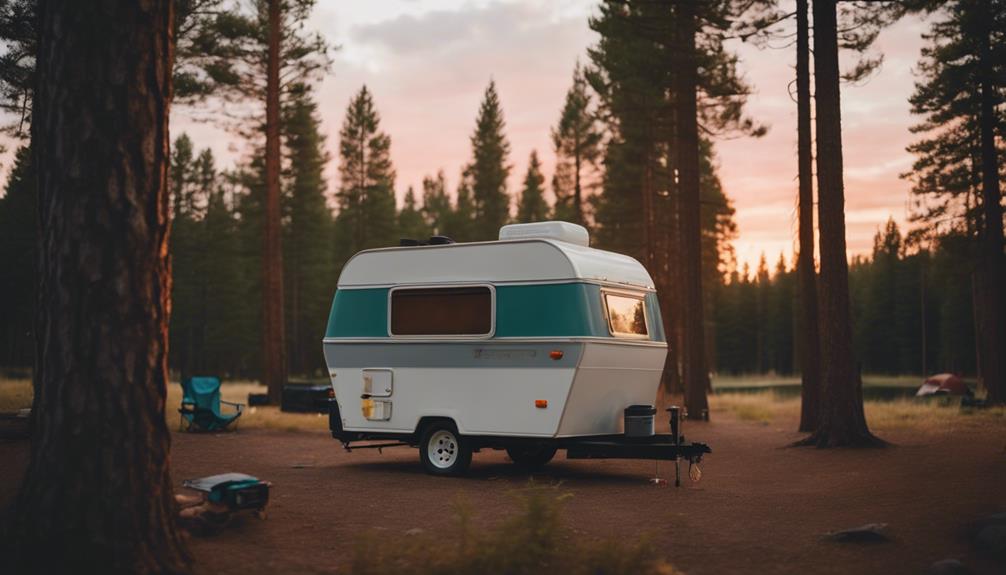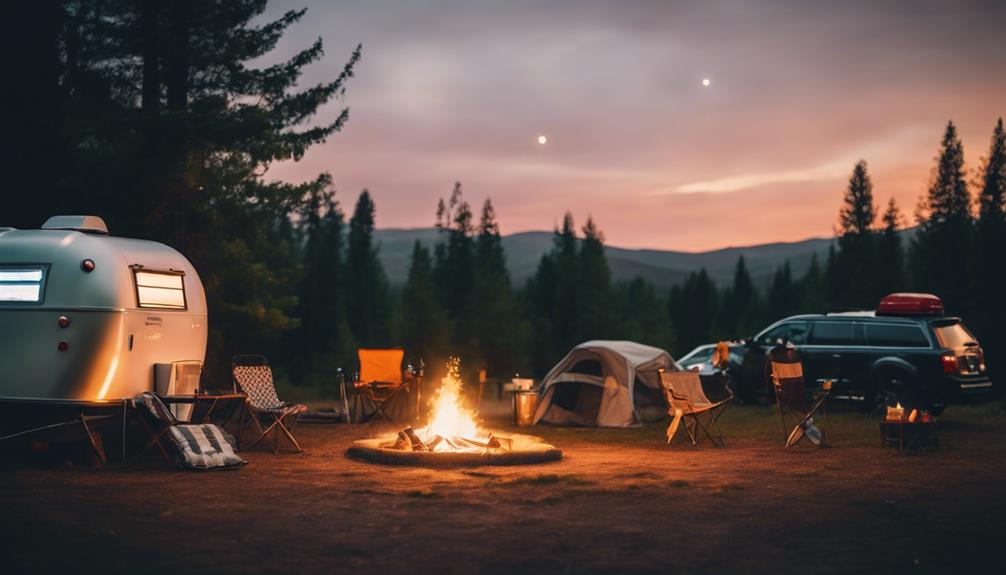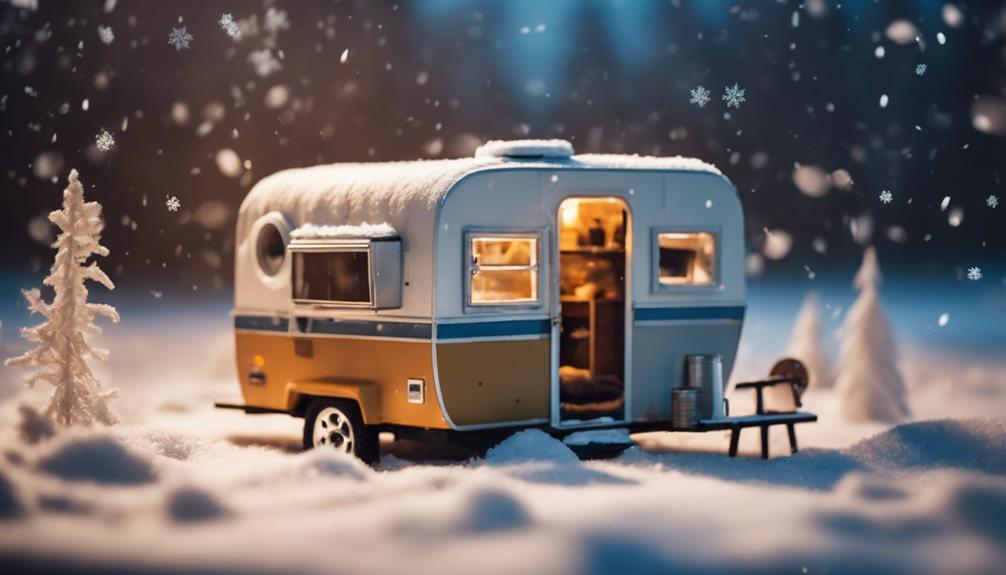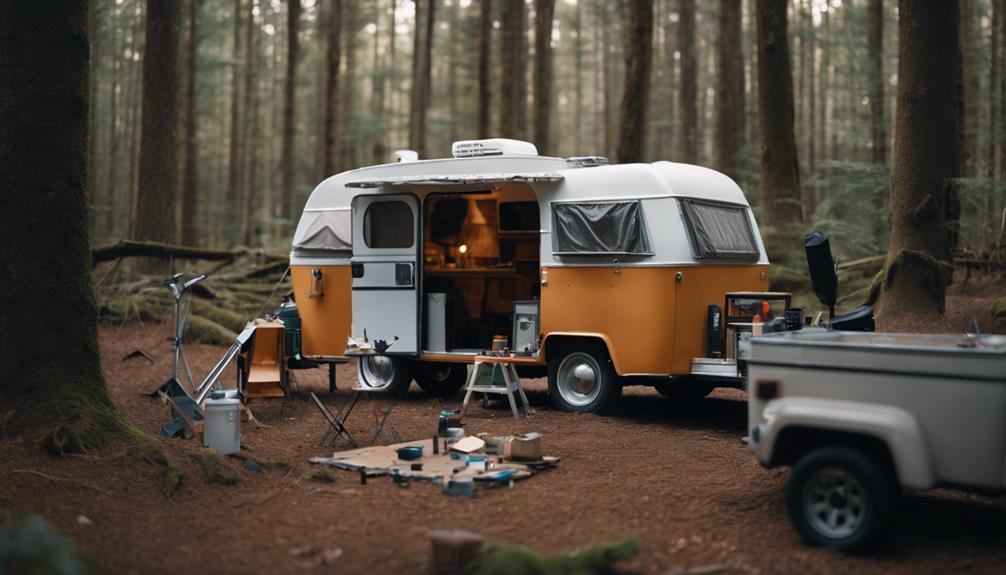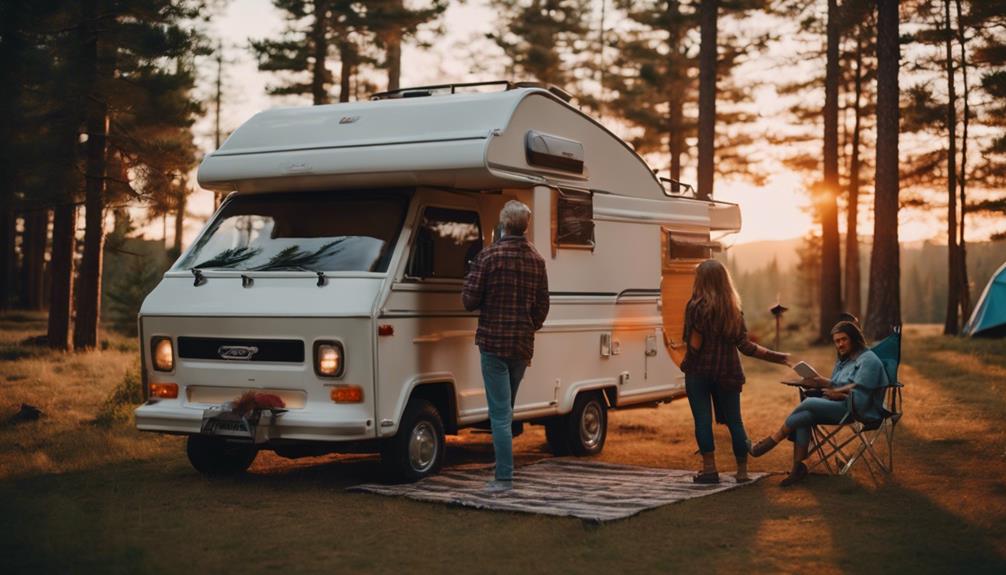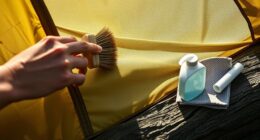To lock your pop-up camper and secure your belongings, start by choosing a safe campground with features like gated entrances and surveillance. Invest in high-quality locks, including deadbolts and heavy-duty padlocks, to reinforce doors and compartments. Don't forget a durable trailer tongue lock to prevent unauthorized towing. Use reliable wheel locks to immobilize the camper, making it harder for thieves to steal it. Additionally, consider adding GPS tracking for real-time monitoring. Combining these strategies will greatly enhance your camper's security, and there are more tips available to further safeguard your belongings.
Key Takeaways
- Upgrade to high-quality deadbolt or keyless locks to enhance the security of your pop-up camper.
- Always lock all doors and compartments when unattended to deter opportunistic theft.
- Install a durable trailer tongue lock to prevent unauthorized towing of the camper.
- Use a reliable wheel lock tailored to your tire size to immobilize the camper.
Choose a Secure Campground
When selecting a campground, opt for one with strong security features like gated entrances and surveillance cameras to keep your pop-up camper safe. A secure campground not only protects your belongings but also gives you peace of mind during your stay. Look for campgrounds with positive security records and read reviews on platforms like the RV Life app to uncover any past issues with thieves.
On-site staff presence is another essential security measure. Having personnel around can deter potential theft and provide immediate assistance if needed. Choose locations in low-crime areas or regions known for their culture of honesty, which can greatly reduce the risk of theft incidents.
Don't underestimate the power of community. Engage with fellow campers to share experiences and insights about campground safety. Building a rapport can foster a community watch mentality, where everyone looks out for each other.
Invest in Quality Locks
Investing in quality locks is vital for guaranteeing your pop-up camper stays secure from theft and unauthorized access. Upgrading to high-quality deadbolt locks or keyless options can greatly improve your camper's security. Standard locks are often keyed alike, making them easy targets for thieves.
Additionally, consider reinforcing your doors and storage compartments with heavy-duty hasps and padlocks. You can also make use of adjustable latches and D-LINKs to secure the roof corners, which are often overlooked but vulnerable areas. Regularly check and maintain the condition of all locks to verify they function properly. Always remember to lock your camper when unattended, even for a short time, as this deters opportunistic thieves who may be scouting nearby.
Here's a quick comparison to help you decide on the right lock options:
| Lock Type | Security Level | Recommended Use |
|---|---|---|
| Deadbolt Lock | High | Main entry door |
| Keyless Lock | Very High | Frequent access areas |
| Heavy-duty Padlock | High | Storage compartments |
| Adjustable Latch | Medium | Roof corners |
| Standard Lock | Low | Temporary use |
Choosing the right lock is vital for your camper's safety.
Install a Trailer Tongue Lock
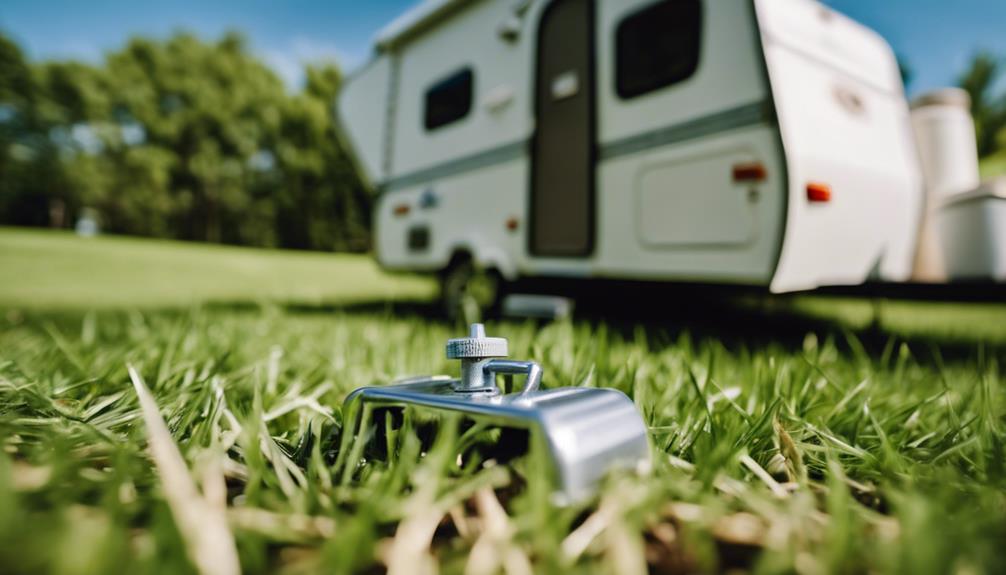
Installing a trailer tongue lock greatly enhances your pop-up camper's security by preventing unauthorized towing. This essential device secures the trailer coupler, making it inoperable when you're not using it.
To maximize the effectiveness of your tongue lock, consider the following tips:
- Choose Durability: Opt for tongue locks designed specifically for trailer hitches. They should resist picking, cutting, and tampering.
- Encircle the Hitch: Select coupler locks that securely encircle the hitch. This provides an additional layer of security against theft.
- Check Compatibility: Verify the tongue lock fits your camper hitch specifications. A secure fit is vital for effective protection.
- Regular Inspections: Regularly inspect your tongue lock for signs of wear or damage to maintain its deterrent capabilities.
Use Wheel Locks
Using wheel locks is an important step in securing your pop-up camper, as they immobilize the wheels and make it nearly impossible for thieves to tow it away. Investing in a reliable wheel lock tailored to your tire size guarantees a snug fit, maximizing security. When combined with other measures like tongue locks and safety chains, you create multiple barriers that effectively deter thieves.
Here's a quick comparison to help you choose the right wheel lock:
| Feature | Description |
|---|---|
| Durability | High-quality materials resist tampering. |
| Ease of Use | Quick to install and remove when needed. |
| Compatibility | Make certain it fits your specific tire size. |
Regularly checking your wheel locks is vital, as wear and tear can compromise their effectiveness. By verifying your wheel locks remain functional, you add an extra layer of security against opportunistic theft. Remember, a wheel lock alone isn't foolproof, but when paired with other protective measures, you greatly enhance the safety of your pop-up camper against tow vehicles.
Implement GPS Tracking
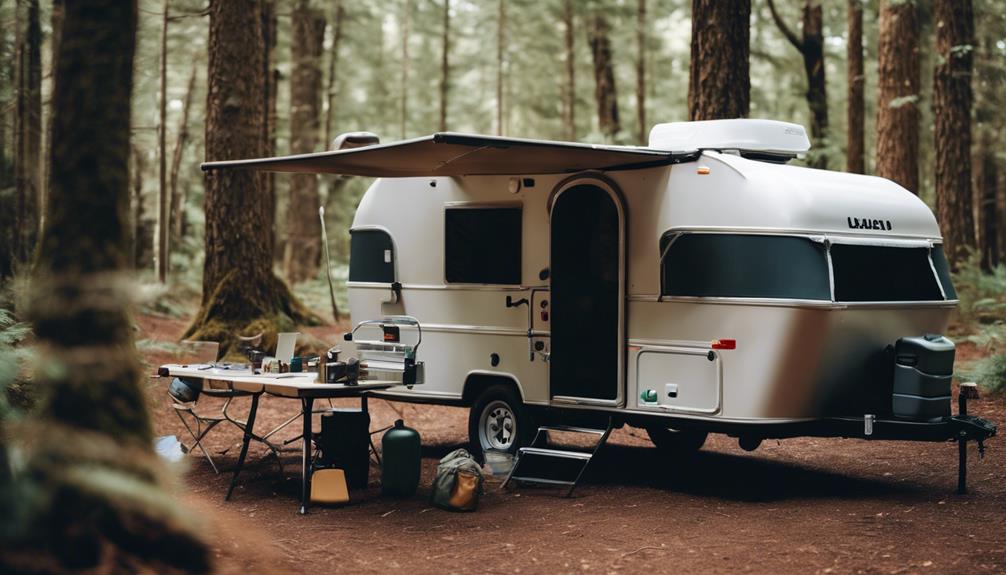
Implementing a GPS tracking system provides real-time location monitoring for your pop-up camper, considerably increasing the chances of recovery if it's stolen. With the right GPS tracking, you can keep an eye on your camper's whereabouts at all times, making quick work of any potential theft by removing the element of surprise for thieves.
Here are four reasons to invest in GPS tracking for your camper:
- Geofencing Alerts: Many devices send notifications if your camper moves outside designated boundaries, adding an extra layer of security.
- Affordable Options: Budget-friendly choices like Apple's Air Tag allow for tracking without expensive subscriptions, making it accessible for all campers.
- Historical Movement Tracking: Some systems provide a history of your camper's movements, helping you identify unusual activity.
- Regular Functionality Checks: Confirm your GPS device is operational by regularly checking its functionality and battery life, so you're always prepared.
Enhance Security Measures
To keep your pop-up camper safe, you should focus on effective locking mechanisms and community engagement.
Make sure you install reliable locks and consider additional security features.
Plus, connecting with fellow campers can help you share tips and strategies for enhanced security.
Effective Locking Mechanisms
Effective locking mechanisms are essential for securing your pop-up camper against unauthorized access when it's not in use. By investing in robust security measures, you can greatly reduce the risk of theft and guarantee your belongings remain safe.
Here are four effective locking mechanisms you should consider:
- High-Quality Door Lock: Upgrade your standard key locks to more secure options. Choose locks with reinforced materials that can withstand tampering.
- Tongue Lock: Install a tongue lock on your camper's hitch. This prevents anyone from easily disconnecting your camper from the tow vehicle.
- Adjustable Latches: Use adjustable latches at the roof corners to secure the structure. This adds an extra layer of protection against unauthorized access.
- D-LINKs and Padlocks: Apply D-LINKs and heavy-duty padlocks to secure the roof. These are specifically designed to prevent easy access to the camper's interior.
Community Engagement Strategies
Connecting with fellow campers through community forums can greatly enhance your understanding of security measures for pop-up campers.
When you engage with the Good Sam Community, you tap into a wealth of knowledge on community safety and theft prevention. Sharing personal experiences can reveal effective security measures for pop-up campers that you mightn't have considered.
Participate in discussions focused on travel trailers to discover best practices for securing belongings while camping. Many campers are enthusiastic to share what works for them, providing you with actionable insights and innovative ideas.
Subscribing to threads that emphasize community safety keeps you updated on the latest advice and strategies from fellow enthusiasts.
Don't forget to report any inappropriate content in the forums. Maintaining a safe and supportive environment encourages more people to share valuable security tips and experiences.
You can also explore the resources available on the Good Sam website, including blogs and articles, to further enhance your understanding of effective security measures.
Frequently Asked Questions
Can You Lock a Pop-Up Camper?
Yes, you can lock a pop-up camper using adjustable latches and key locks. Make sure to secure all windows and doors, and consider additional measures like padlocks for better protection against unauthorized access.
Are Pop-Up Campers Secure?
While pop-up campers might seem like a trusty steed, they're not completely secure. Their latches and locks can be vulnerable, so it's wise to enhance security with additional measures to protect your belongings effectively.
How Do You Lock Your Camper?
To lock your camper, check all door and window locks, use adjustable latches, and secure them with padlocks. Don't forget to invest in a trailer tongue lock for extra protection against theft.
How Do You Stabilize a Pop-Up Camper?
To stabilize your pop-up camper, deploy the stabilizer jacks at each corner and use leveling blocks under the wheels. Check for stability by testing the floors before enjoying your camping experience.
Conclusion
To sum up, securing your pop-up camper is essential for peace of mind during your adventures.
Did you know that nearly 30% of campers have experienced theft while on the road?
By choosing a secure campground, investing in quality locks, and implementing additional measures like GPS tracking, you can greatly reduce the risk of losing your belongings.
Prioritizing your camper's security not only protects your gear but also lets you focus on enjoying your outdoor experiences to the fullest.

